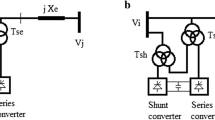Abstract
The Flexible AC Transmission System (FACTS) devices are being commissioned in electrical power systems across the globe owing to the vast array of benefits they offer. The optimal performance of the FACTS devices can be harnessed only if they are installed at a strategic location. In this paper, the authors suggest the merit of multiobjective cuckoo search (MOCS) algorithm in mitigation of transmission losses by strategically installing unified power flower controller (UPFC) at an optimal location. Active power loss and reactive power loss reduction is the multiobjective optimization considered for the study. The Pareto-optimal technique is employed to extract the Pareto-optimal solution for the multiobjective problem considered. The Fuzzy logic method is utilized to yield the best-compromise solution from the pool of Pareto-optimal solution. The proposed approach is tested on a standard IEEE 30 bus test system. Furthermore, the efficacy of the MOCS algorithm is demonstrated by comparing the results with that of multiobjective particle swarm optimization (MOPSO).








Similar content being viewed by others
Explore related subjects
Discover the latest articles, news and stories from top researchers in related subjects.References
Dash SP, Subhashini KR, Satapathy JK (2019) Optimal location and parametric settings of FACTS devices based on JAYA blended moth flame optimization for transmission loss minimization in power systems. Microsyst Technol. https://doi.org/10.1007/s00542-019-04692-w
Dutta S, Roy PK, Nandi D (2015) Optimal location of UPFC controller in transmission network using hybrid chemical reaction optimization algorithm. Int J Electr Power Energy Syst 64:194–211
Galiana FD, Almeida K, Toussaint M, Griffin J (1996) Assessment and control of the impact of FACTS devices on power system performance. IEEE Trans Power Syst 11(4):1931–1936
Gyugyi L, Schauder CD, Williams SL, Rietman TR, Torgerson DR, Edris A (1995) The unified power flow controller: a new approach to power transmission control. IEEE Trans Power Deliver 10(2):1085–1097
Hingorani NG, Gyugyi L (2000) Understanding FACTS: concepts and technology of flexible AC transmission Systems. IEEE Press, New York
Kennedy J, Eberhart R (1995) Particle swarm optimization. In: IEEE International Conference on Neural Networks, Perth, pp. 1942–1948.
Mani SM, Seksena SBL (2017) A cost effective voltage sag compensator for distribution system. Int J Syst Assur Eng Manag 8(1):56–64
Mathur RM, Varma RK (2002) Thyristor-based FACTS controllers for electrical transmission systems. IEEE Press, New York
Nartu TR, Matta MS, Koratana S, Bodda RK (2019) A fuzzified Pareto multiobjective cuckoo search algorithm for power losses minimization incorporating SVC. Soft Comput 23:10811–10820
Noroozian M, Andersson G (1993) Power flow control by use of controllable series components. IEEE Trans Power Deliver 8(3):1420–1429
Noroozian M, Angquist L, Ghandhari M, Andersson G (1997) Use of UPFC for optimal power flow control. IEEE T Power Deliver 12(4):1629–1634
Mithu S (2013) Load flow studies with power injection model. Dissertation, National Institute of Technology, Rourkela, India.
Shaheen HI, Rashed GI, Cheng SJ (2008) Optimal location and parameters setting of UPFC based on GA and PSO for enhancing power system security under single contingencies. In: Proceedings of the IEEE Power and Energy Society General Meeting-Conversion and Delivery of Electrical Energy, Pittsburgh, pp. 1–8
Shrawane Kapse SS, Daigavane MB, Daigavane PM (2018) Improvement of ORPD Algorithm for Transmission Loss Minimization and Voltage Control Using UPFC by HGAPSO Approach. J Inst Eng India Ser B 99:575–585
Singh SN, Erlich I (2005) Locating UPFC for enhancing power system load-ability. In: 2005 International Conference on Future Power Systems. IEEE, pp. 1–5.
Solmaz K, Amin MH, Hazlie Bin M (2015) Comparative study of multi-objective optimal power flow based on particle swarm, evolutionary programming, and genetic algorithm. Electr Eng 97(1):1–1
Taher SA, Amooshahi MhK (2012) New approach for optimal UPFC placement using hybrid immune algorithm in electric power systems. Int J Electr Power Energy Syst 43:899–909
Venkatesh B, Gooi HB (2006) Optimal siting of unified power flow controller. Electr Power Compon Syst 34(3):46–69
Vijay BK, Ramaiah V (2019) Enhancement of dynamic stability by optimal location and capacity of UPFC: a hybrid approach. Energy. https://doi.org/10.1016/j.energy.2019.116464
Yang XS, Deb S (2009) Cuckoo search via l´evy flights. In: IEEE world congress on nature and biologically inspired computing, Coimbatore, India, pp 210–214
Yang XS, Deb S (2010) Engineering optimization by cuckoo search. Int J Math Model Numer Optim 1(4):330–343
Yang XS, Deb S (2011) Multiobjective cuckoo search for design optimization. Comput Oper Res 40(6):1616–1624
Author information
Authors and Affiliations
Corresponding author
Additional information
Publisher's Note
Springer Nature remains neutral with regard to jurisdictional claims in published maps and institutional affiliations
Rights and permissions
About this article
Cite this article
Rao, N.T., Sankar, M.M., Rao, S.P. et al. Comparative study of Pareto optimal multi objective cuckoo search algorithm and multi objective particle swarm optimization for power loss minimization incorporating UPFC. J Ambient Intell Human Comput 12, 1069–1080 (2021). https://doi.org/10.1007/s12652-020-02142-4
Received:
Accepted:
Published:
Issue Date:
DOI: https://doi.org/10.1007/s12652-020-02142-4




